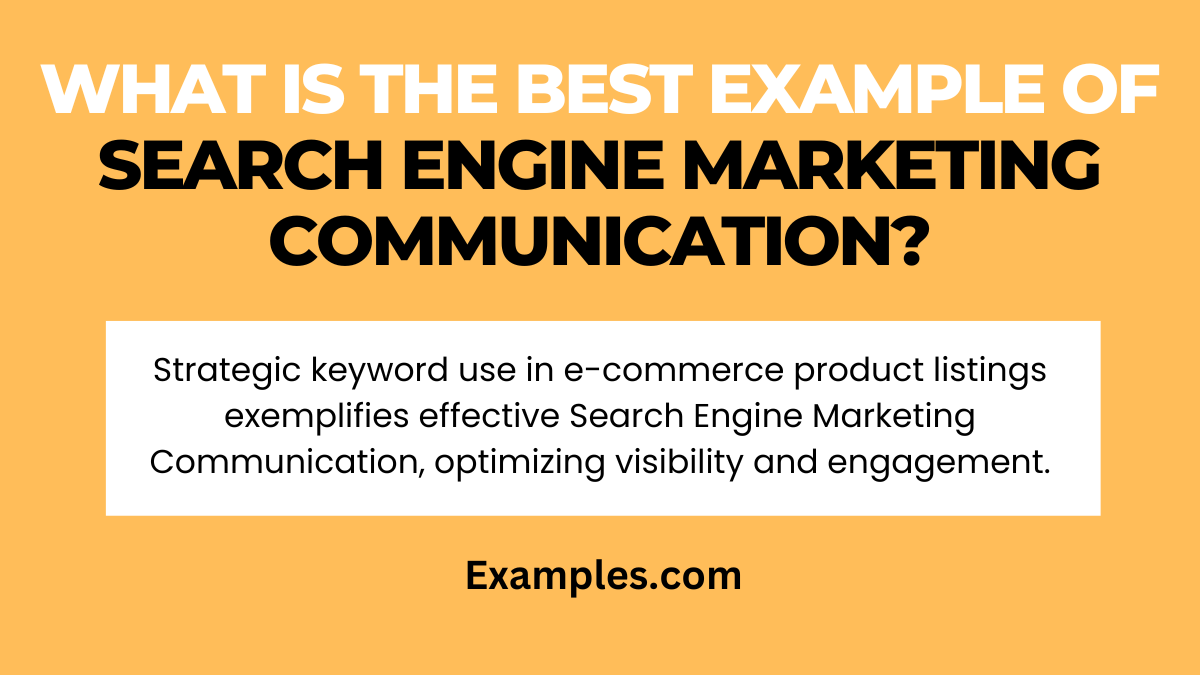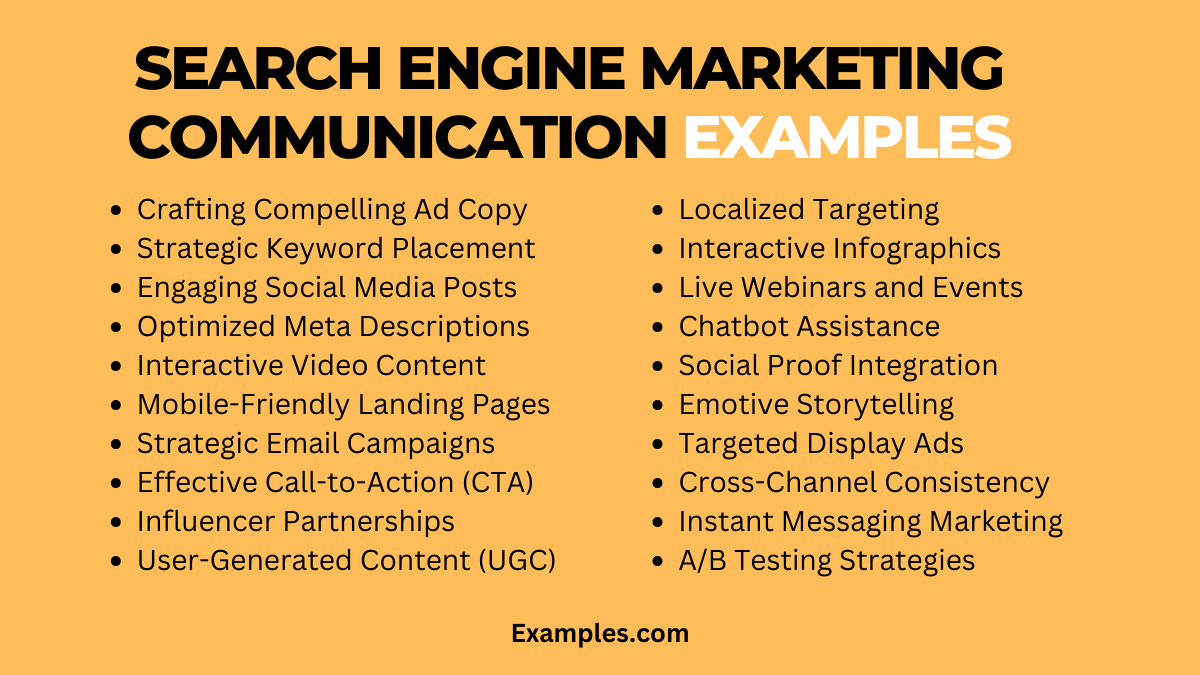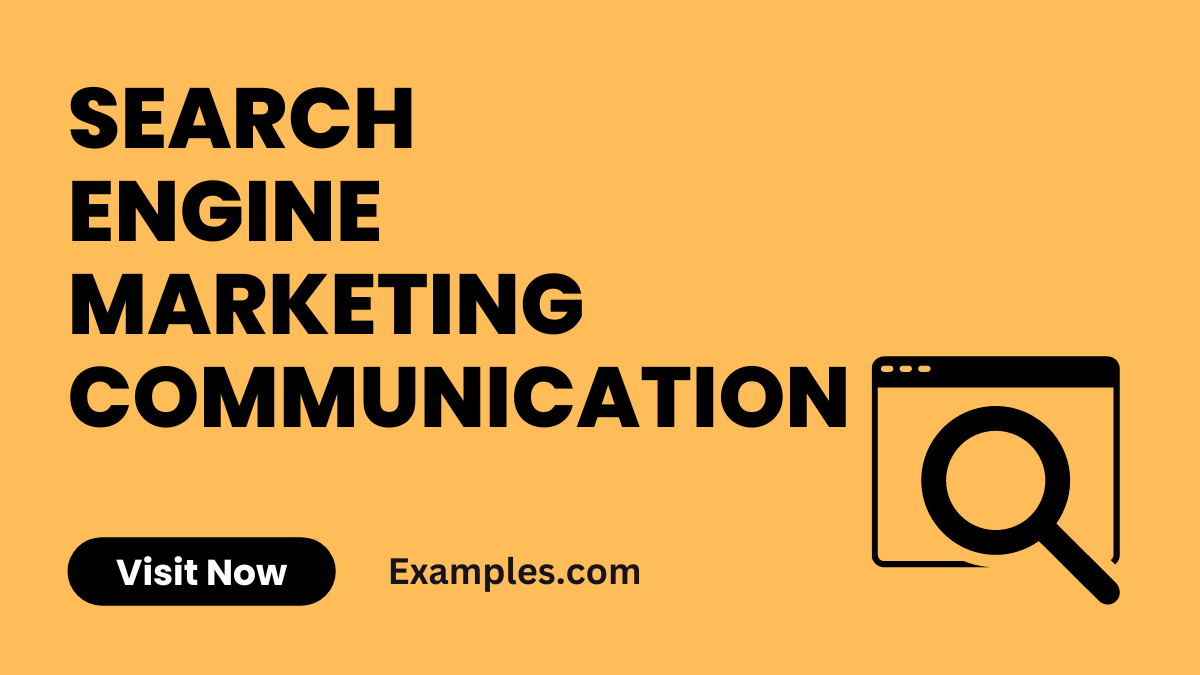19+ Search Engine Marketing (SEM) Communication Examples
Unlock the power of Search Engine Marketing Communication with our comprehensive guide. From impactful strategies to real-world Communication Examples, dive into the intricacies of leveraging SEO for maximum online visibility. Whether you’re a novice or a seasoned marketer, our guide equips you with actionable insights and effective examples to amplify your digital presence. Explore the dynamic realm of Search Engine Marketing Communication and transform your approach to online success
What is Search Engine Marketing Communication?

Search Engine Marketing Communication refers to the strategic use of targeted messages and content in online marketing campaigns. It involves optimizing content to enhance visibility on search engines, driving traffic, and ultimately achieving marketing goals. In simple terms, it’s the art of effectively conveying messages online, ensuring they resonate with the audience, and leveraging search engine platforms for optimal reach and impact. Understanding this concept is pivotal for successful digital marketing endeavors.
What is The Best Example of Search Engine Marketing Communication?

In the realm of Search Engine Marketing, a stellar example is the way a leading e-commerce platform strategically uses targeted keywords in its product listings. By aligning product descriptions with frequently searched terms, the platform ensures high visibility on search engine results pages (SERPs). This not only boosts organic traffic but also exemplifies the power of effective communication with search algorithms. This method serves as a prime illustration of leveraging SEM communication for optimal online visibility and user engagement.
20 Search Engine Marketing Communication Examples

Enhance your digital strategy with these Search Engine Marketing Communication examples. Explore diverse approaches that maximize online visibility, engage target audiences, and drive conversions. These real-world instances showcase the power of effective communication in digital marketing, offering inspiration and practical insights for your campaigns.
- Crafting Compelling Ad Copy: “Unlock success with our premium services! Irresistible deals await—shop now for exclusive offers.”
- Strategic Keyword Placement: “Boost visibility by strategically placing high-impact keywords in your content. Elevate search rankings and attract your target audience effortlessly.”
- Engaging Social Media Posts: “Foster community engagement through captivating social media posts. Build connections, drive conversations, and amplify your brand presence.”
- Optimized Meta Descriptions: “Entice clicks with compelling meta descriptions. Convey value, include keywords, and compel users to explore what your page has to offer.”
- Interactive Video Content: “Dazzle audiences with interactive video content. From tutorials to behind-the-scenes glimpses, leverage videos to captivate and inform.”
- Mobile-Friendly Landing Pages: “Optimize landing pages for mobile users. Seamless navigation and quick access enhance the user experience, boosting conversions on the go.”
- Strategic Email Campaigns: “Drive engagement through personalized email campaigns. Tailor messages to your audience, delivering relevant content that sparks interest.”
- Effective Call-to-Action (CTA): “Master the art of CTAs. From ‘Shop Now’ to ‘Subscribe,’ compel action with clear, persuasive, and strategically placed calls-to-action.”
- Influencer Partnerships: “Collaborate with influencers for authentic promotion. Leverage their reach to connect with new audiences and build credibility.”
- User-Generated Content (UGC): “Harness the power of UGC. Encourage customers to share their experiences, creating authentic content that resonates with your audience.”
- Localized Targeting: “Tailor your message with localized targeting. Speak directly to regional audiences, addressing specific needs and preferences.”
- Interactive Infographics: “Present information dynamically with interactive infographics. Enhance understanding and engagement with visually appealing, shareable content.”
- Live Webinars and Events: “Connect with your audience in real-time through live webinars. Foster engagement, answer questions, and showcase expertise.”
- Chatbot Assistance: “Implement chatbots for instant customer support. Enhance user experience by providing timely assistance and information.”
- Social Proof Integration: “Showcase social proof on your website. Display testimonials, reviews, and endorsements to build trust and credibility.”
- Emotive Storytelling: “Tell compelling stories that resonate emotionally. Create a connection with your audience through narratives that evoke feelings and empathy.”
- Targeted Display Ads: “Refine your ad targeting for precision. Reach specific demographics and interests, ensuring your message reaches the most relevant audience.”
- Cross-Channel Consistency: “Maintain consistent messaging across channels. Ensure brand coherence, reinforcing key messages for a unified brand identity.”
- Instant Messaging Marketing: “Leverage instant messaging platforms for marketing. Engage users directly, providing personalized content and support.”
- A/B Testing Strategies: “Optimize campaigns with A/B testing. Experiment with variations to identify the most effective elements, refining your approach for optimal results.”
Search Engine Marketing Communication Examples for Business
Harnessing the power of Search Engine Marketing (SEM) is essential for business growth. Explore these impactful examples that exemplify effective communication strategies in the dynamic world of online marketing.
- Leveraging Local Presence: Optimize ads with location-specific keywords to connect with local customers actively seeking products or services.
- Seasonal Promotions: Incorporate timely ad content showcasing limited-time offers, aligning SEM communication with seasonal demand.
- Dynamic Product Showcasing: Utilize dynamic ad content that adapts based on user behavior, providing tailored product recommendations for enhanced engagement.
- Educational Content Marketing: Create informative ad copies and landing pages to educate users, establishing authority and fostering trust in your industry.
- Cross-Channel Consistency: Ensure consistency in messaging across various online channels, reinforcing brand identity and building a unified online presence.
Search Engine Marketing Communication Examples for a Company
For companies aiming to excel in the digital landscape, effective SEM communication is paramount. Delve into these tailored examples that highlight strategic approaches for companies to optimize their online visibility.
- Brand Reputation Management: Employ SEM to address negative search results, strategically promoting positive content to enhance overall brand perception.
- Competitive Keyword Domination: Target industry-specific keywords to outperform competitors, establishing your company as a leader in search engine results.
- Innovative Product Launch: Craft compelling ads and landing pages to generate buzz for a new product, creating anticipation and driving successful launches.
- Employee Recruitment Campaigns: Utilize SEM to showcase company culture and benefits, attracting top talent with targeted recruitment ads.
- Localized Service Expansion: Implement geo-targeted campaigns when expanding services to new locations, ensuring effective communication with the local audience.
How does Search Engine Marketing Communication Work?
Understanding SEM dynamics is crucial for online success. SEM involves strategic advertising on Google, targeting keywords. The process includes bid management, ad creation, and optimization for visibility.
- Keyword Research and Selection: Conduct in-depth research, choose short and long-tail keywords for diverse search intents.
- Ad Creation and Copywriting: Craft compelling ad copies, highlight USPs, and create a clear call-to-action.
- Bid Management: Efficiently manage bids, adjust based on performance data for optimal placements.
- Landing Page Optimization: Ensure landing pages align with ad content, optimizing for user experience and relevance.
- Ad Positioning and Ad Rank: Understand factors like bid, ad relevance, and expected click-through rate determining Ad Rank.
- Conversion Tracking: Implement tracking, measure specific actions on your website, and refine marketing strategies.
How to Use the Internet and Search Engine in Digital Marketing?
Leverage the internet and search engines effectively with these steps for a strong online presence.
- Build a User-Friendly Website: Create a visually appealing, easy-to-navigate, and SEO-optimized website.
- Implement SEO Strategies: Incorporate SEO techniques for improved organic visibility.
- Content Marketing: Develop a content strategy aligned with your audience’s needs.
- Social Media Integration: Integrate social media to connect with your audience and drive traffic.
- Email Marketing Campaigns: Implement targeted email campaigns to nurture leads and maintain engagement.
- Pay-Per-Click Advertising: Utilize PPC advertising for immediate visibility with compelling ad copies.
- Analytics and Monitoring: Regularly monitor website analytics using tools like Google Analytics.
- Online Reputation Management: Manage your online reputation by monitoring reviews and engaging with your audience.
- E-commerce Integration: Optimize your website for e-commerce with a streamlined purchasing process.
- Continuous Optimization: Regularly assess and optimize your digital marketing strategies to adapt to evolving consumer behaviors.
What are the Benefits of Search Engine Marketing Communication?
What are the Benefits of Search Engine Marketing Communication?
Unlocking the potential of Search Engine Marketing (SEM) communication offers a myriad of advantages for businesses striving to thrive in the digital landscape. From targeted audience engagement to measurable results, SEM communication plays a pivotal role in enhancing online visibility and achieving marketing goals.
- Targeted Audience Reach: SEM allows businesses to precisely target their audience based on demographics, interests, and search behavior, ensuring ads reach the most relevant potential customers.
- Cost-Effectiveness: With pay-per-click (PPC) advertising models, businesses only pay when users click on their ads. This cost-effective approach ensures budget optimization and efficient resource utilization.
- Measurable Results: SEM provides comprehensive analytics tools that enable businesses to track and measure the performance of their campaigns, including clicks, impressions, conversions, and return on investment (ROI).
- Enhanced Brand Visibility: By appearing at the top of search engine results pages (SERPs), businesses can significantly enhance brand visibility, fostering trust and recognition among their target audience.
- Attracting High-Quality Leads: SEM allows businesses to attract users actively searching for products or services similar to theirs, resulting in higher-quality leads with a genuine interest in the offerings.
- Competitive Edge in the Digital Space: Leveraging SEM effectively provides a competitive advantage, allowing businesses to outshine competitors, capture market share, and stay ahead in the dynamic digital landscape.
Tips for Effective Search Engine Marketing Communications
- Crafting Engaging Ad Copies: Develop compelling ad copies that resonate with your audience, incorporating relevant keywords and a persuasive call-to-action to encourage clicks.
- Keyword Research and Selection: Conduct thorough keyword research to identify high-performing keywords relevant to your business. Choose a mix of short-tail and long-tail keywords to capture diverse audiences.
- Landing Page Optimization: Optimize landing pages to align with ad content, ensuring a seamless user experience with clear messaging, relevant visuals, and a straightforward conversion process.
- Budget Management and Bid Strategy: Effectively manage your advertising budget by setting realistic daily limits. Employ a strategic bid strategy, adjusting bids based on keyword performance and campaign goals.
- Regular Performance Monitoring: Monitor campaign performance regularly, analyzing key metrics such as click-through rates, conversion rates, and return on ad spend. Make data-driven adjustments for continuous improvement.
- Ad Extension Utilization: Enhance ad visibility and provide additional information to users by utilizing ad extensions. Include site link extensions, callout extensions, and structured snippet extensions to maximize impact.
In conclusion, mastering Search Engine Marketing Communication is pivotal for digital success. Employing strategic tactics, leveraging engaging examples, and embracing effective communication principles contribute to a robust online presence. The dynamic synergy between marketing and communication opens doors to unparalleled visibility, audience engagement, and business growth, making it an indispensable tool in the digital marketer’s arsenal.



